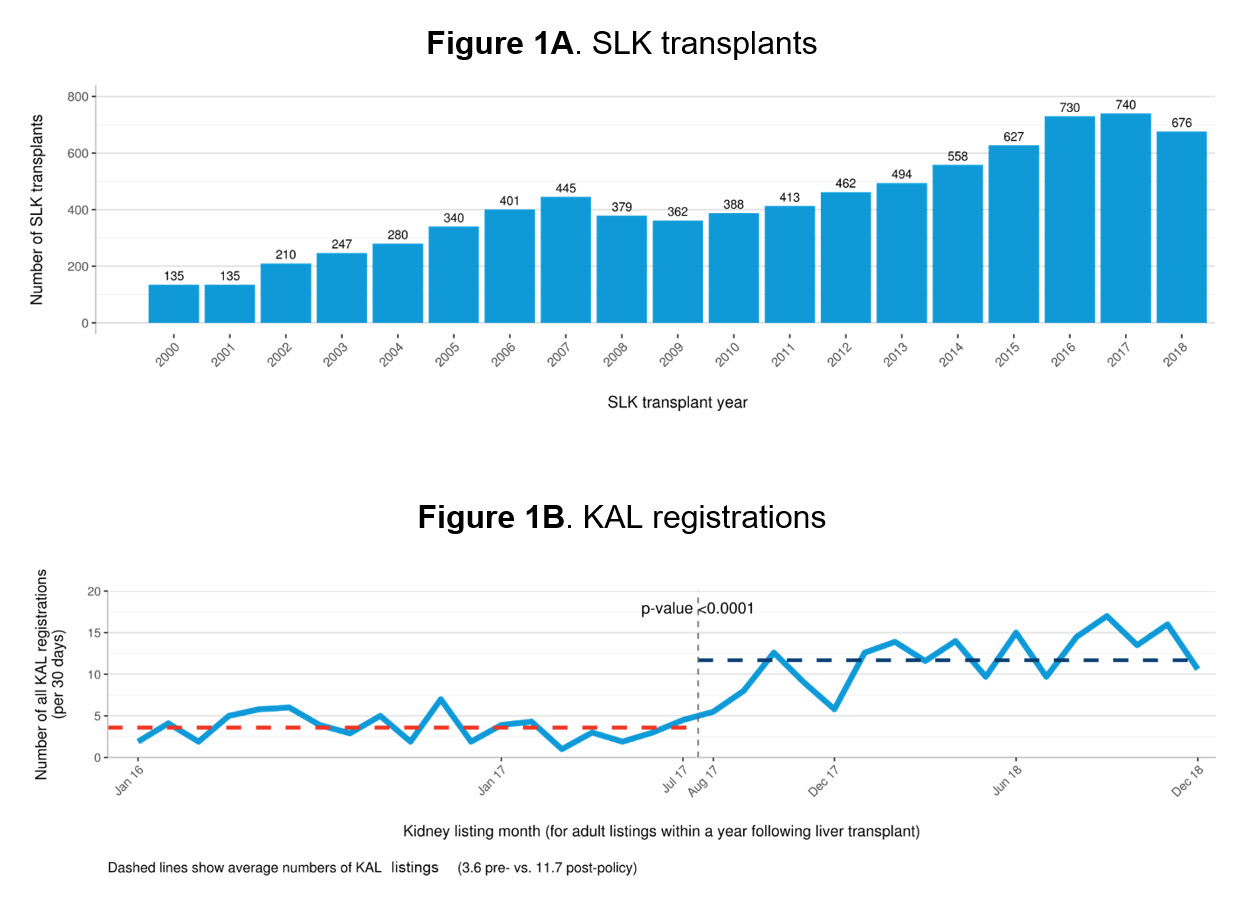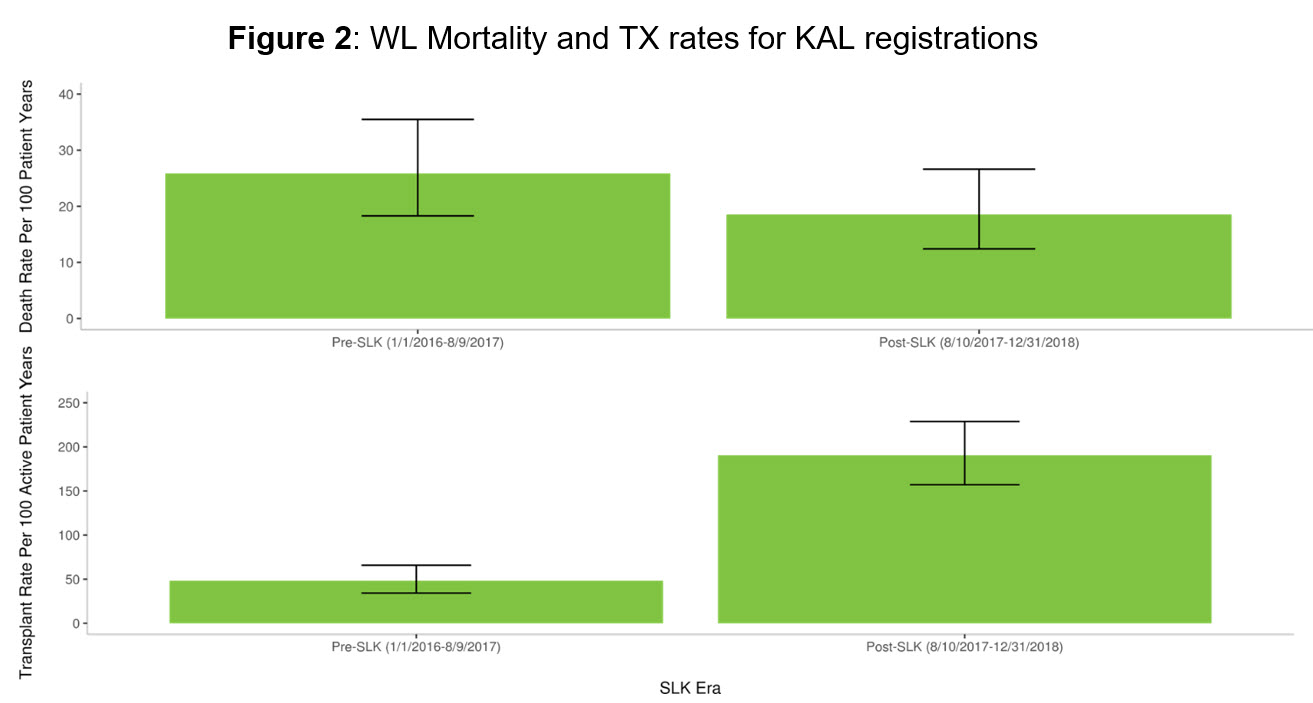One Year of the OPTN’s SLK Allocation Policy
1United Network for Organ Sharing, Richmond, VA, 2Yale School of Medicine, New Haven, CT, 3Univ of Colorado School of Medicine, Aurora, CO, 4UCSF, San Francisco, CA
Meeting: 2020 American Transplant Congress
Abstract number: B-011
Keywords: Allocation, Kidney, Kidney/liver transplantation, Waiting lists
Session Information
Session Name: Poster Session B: Kidney Deceased Donor Allocation
Session Type: Poster Session
Date: Saturday, May 30, 2020
Session Time: 3:15pm-4:00pm
 Presentation Time: 3:30pm-4:00pm
Presentation Time: 3:30pm-4:00pm
Location: Virtual
*Purpose: Simultaneous Liver-Kidney (SLK) allocation policy went into effect on 8/10/17, establishing medical eligibility criteria for adult SLK candidates and creating a “Safety Net” for kidney after liver (KAL) recipients (listed on the kidney (KI) waiting list (WL) within 1-year post-liver (LI) transplant (TX)) who did not recover renal function, or quickly developed advanced renal dysfunction, post-TX.
*Methods: OPTN data was analyzed for SLK and KAL TX pre- (1/1/16-8/9/17) and post- (8/10/17-12/31/18) policy implementation. SLK/KAL WL registrations were analyzed as of 12/31/18.
*Results: As of 12/31/18, 975 (92%) SLK registrations met the eligibility criteria (99% due to Chronic KI Disease (CKD)). Of CKD eligible registrations, 57% qualified via dialysis, 18% eGFR/CrCl 0-<20; 11% eGFR/CrCl 20-<25; 14% eGFR/CrCl 25-30. There was a 9% decrease in SLK TX in the first full year post-implementation from a record 740 in 2017 to 676 in 2018; this is a statistically significant decrease in the average number of SLK TX/month (61.6 pre vs. 55.4 post; p=0.0089). There were no significant impacts to pediatric or KP transplant counts (p=0.1060 and p=0.1895 respectively).
Of 209 KAL registrations, 94 (45%) were eligible for Safety Net priority. There was no significant change in KAL WL mortality rates (25.9 (18.3, 35.5) vs. 18.5 (12.4, 26.6) per 100 patient yrs), but there was a significant 4-fold increase in TX rates pre- vs. post-policy (48.2 (34.2, 65.8) vs. 190.4 (157.1, 228.8) per 100 active patient yrs).
Subsequently, there were 124 KAL TX performed post-policy (Figure 1B); 110 (89%) were allocated in Safety Net priority with the rest allocated based on the candidate’s usual priority. The majority (69%) of KAL TX used KDPI 35-85% KI (no KAL living donor KI TX), and 40% had a reported renal failure diagnosis at TX of Hepatorenal Syndrome.
*Conclusions: The implementation of the SLK policy has slowed the annual increase in the number of SLK TX and the Safety Net priority has directed KI to the immediate post-LI TX recipients in need. To date, the impacts on post-TX outcomes have yet to be determined, and further monitoring is planned as data become available.
To cite this abstract in AMA style:
Wilk A, Formica R, Wiseman A, Hirose R, Mulligan D, Stewart D. One Year of the OPTN’s SLK Allocation Policy [abstract]. Am J Transplant. 2020; 20 (suppl 3). https://atcmeetingabstracts.com/abstract/one-year-of-the-optns-slk-allocation-policy/. Accessed January 5, 2026.« Back to 2020 American Transplant Congress


